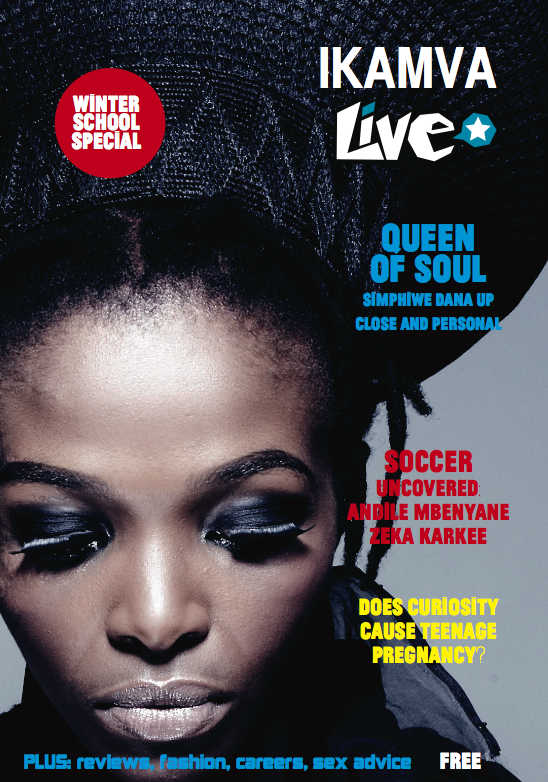Here’s a round-up of all the main events of the last 3 months.
ISSUE 1 DISTRIBUTION COMPLETED
The Live Magazine team completed the distribution of issue 1 of Live Magazine SA, with 50,000 copies going out to shops, schools, universities, libraries and malls, as well as into the hands of young people at taxi ranks and train stations via our street team distribution network. The distribution concentrated on urban and township locations across Cape Town and Gauteng initially, with two phases of distribution before and after Christmas.
ISSUE 2 HITS THE STREETS
In late February the second issue of Live Magazine SA came back from the printers and began its distribution. Featuring supermodel Carmen Solomons (from Kraaifontein) on the cover, the magazine covers issues including gangsterism, beauty, press freedom, financial awareness, careers guidance, homosexuality and xenophobia, as well as featuring fashion, music, cars, cartoons, gadgets and a sideways look at racism and political correctness.
Personal highlights are the 5 page photo-documentary feature shot in the Eastern Cape by Cebisa Zono, our guide to surviving university life and our cover story interview with Carmen Solomons (not to mention the beautiful photography shot by 19 year old Dylan Louw).
You can read the whole issue online here.
We’re also excited to be working in partnership with Johannesburg-based media arts organisation Kileketla for the distribution of issue 2.
YOUNG PEOPLE
Several member of the first cohort of Live Mag SA core contributors have progressed from the project, some into full time tertiary education and others into full-time work. Highlights include Lauren Snyders (who got a full-time role at Bush Radio and can be sometimes heard reading the news), Cristle Mokwape (junior editorial role at Stellenbosch University), Vanessa Kungwane (who secured a Rhodes Scholarship to study in Grahamstown), and Jayson White (went on to Big Fish film school on a bursary).
We inducted a brand new cohort of young people in mid February, including referrals from our NGO partners Ikamva Youth in Masiphumelele.
Meanwhile, the team have been inundated with requests to get involved via email, SMS and our Facebook page, from readers who have picked up the magazine all over the country, and are working on a system to able to offer the ability to contribute to young people outside Cape Town in a fair and meritocratic way.
We appointed a new editor, Ndu Ncgobo, and deputy editor, Jessica Edgson, as well as brand new range of editorial positions for other contributors.
We also introduced a new range of contributor incentives including a Wall of Fame for alumni, and the Ultimate Overlord prize – where one contributor each week received a bonus voucher for performance, as well as qualifies to wear the coveted Ultimate Overlord t-shirt.
ABC PROCESS IN MOTION
Live Magazine SA is in the process of registering and qualifying for an official Audit Bureau of Circulation rating, which would give us an official circulation figure. We were pleased to find out that we would be able to have our street team distribution audited (currently makes up approximately 30% of our circulation), and that we would receive our rating in July 2012.
MOBILE LAUNCH
In February I completed my final project plan and pitch of the Fellowship Year which will focus on building and launching a mobile site for Live Magazine SA. As part of this process my team and I spent a large amount of time speaking to industry experts, meeting agencies and trying to decide the best platform and approach. In the end we have decided to go with a WordPress driven solution and are delighted to announce that we will be working with Cape Town-based agency Creative Spark for the build.
MENTORS
Live Mag SA recruited a new part-time editorial mentor, Lee Middleton, an American freelance journalist based in Cape Town. We also continued to work with a host of existing and new mentors, paid and voluntary, across several disciplines, including documentary photographer Alexia Webster, and artist Mike Saal helping with illustration – as well as guest talks from Rufus Pollock, Richard Dejager, The President Design agency, filmmaker Richard Starkey, and a communications workshop from actor Mary Steward.
LIVE MAG SA YOUTUBE CHANNEL PHASE 2
Google SA agreed to another 6 months of sponsorship of our YouTube team, working in parallel to the editorial team to create youth culture content in video. Our aim over the first half of 2012 is to build up our channel and its subscriber base, showing how video content can entertain, inspire and educate, whilst training a rolling cohort of young people to become YouTube experts. The deal includes advertorial in Live Magazine.
FELLOWSHIP RENEWED
In December I was delighted to find out that the Shuttleworth Foundation had awarded me a second year of Fellowship beginning on March 1st 2012. The focus for year 2 will be building on a whirlwind first year to establish the business model, build our team, grow our revenue streams and make significant progress towards sustainability, as well as launching on mobile and developing a small hub in Gauteng.
PRESS AND PR
Live Magazine SA and its contributors. Mentors were featured in Arise magazine in the UK, SA’s Sunday Times, Wallpaper* magazine (mentor Nkuli Mlangeni), CityPress (editor Nicola Daniels), the Cape Argus, Cosmopolitan (Cristle Mokwape), and Drum magazine (Nkuli Mlangeni and Nicola Daniels).
COMMONS PITCH
Live Mag SA members, including myself, collaborated with the MAL Foundation and got to the Common Pitch South Africa finals presented by Design Indaba http://www.commonpitchsa.com/ for a collaborative idea that would bridge the societal and geographical divide between established and up’n coming creatives in Cape Town.
MEANWHILE, BACK IN THE UK…
Live Magazine SA produced a beautiful new edition, with a simultaneous release with Live Mag SA, and hitting a 50,000 print run, distributed across the UK.
While the mothership, Livity UK, were winning awards left, right and centre, with 3 MAA Awards for our Final Verse campaign, and we were included in NESTA’s Britains Top 5o Radicals. Viva!


